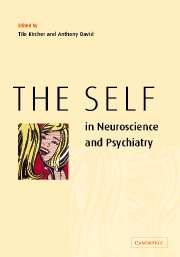Book contents
- Frontmatter
- Contents
- List of contributors
- Introduction: the self and neuroscience
- Part I Conceptual background
- Part II Cognitive and neurosciences
- 5 The multiplicity of consciousness and the emergence of the self
- 6 Asynchrony, implicational meaning and the experience of self in schizophrenia
- 7 Self-awareness, social intelligence and schizophrenia
- 8 The neural correlates of self-awareness and self-recognition
- 9 Autonoetic consciousness
- 10 The neural nature of the core SELF: implications for understanding schizophrenia
- Part III Disturbances of the self: the case of schizophrenia
- References
7 - Self-awareness, social intelligence and schizophrenia
from Part II - Cognitive and neurosciences
Published online by Cambridge University Press: 18 December 2009
- Frontmatter
- Contents
- List of contributors
- Introduction: the self and neuroscience
- Part I Conceptual background
- Part II Cognitive and neurosciences
- 5 The multiplicity of consciousness and the emergence of the self
- 6 Asynchrony, implicational meaning and the experience of self in schizophrenia
- 7 Self-awareness, social intelligence and schizophrenia
- 8 The neural correlates of self-awareness and self-recognition
- 9 Autonoetic consciousness
- 10 The neural nature of the core SELF: implications for understanding schizophrenia
- Part III Disturbances of the self: the case of schizophrenia
- References
Summary
Abstract
The purpose of this chapter is to review the evidence concerning mirror self-recognition as a measure of self-awareness and examine its applicability to schizophrenia. The evidence suggests that the ability to identify yourself correctly in a mirror is not only related to the capacity to conceive of yourself, but may also be related to your ability to take into account what other individuals may know, want or intend to do. This ability to make accurate inferences about mental states in others (known as mental state attribution, theory of mind or social intelligence) begins to emerge during childhood at the same point in time as mirror self-recognition. Species that fail to recognize themselves in mirrors fail to show any evidence that they can infer mental states in one another. Also consistent with the proposition that these phenomena go hand in hand, recent neuropsychological evidence shows that self-awareness and mental state attribution in humans appear to be a byproduct of brain activity that is related to the frontal cortex. As detailed here and elsewhere in this volume, there is growing evidence that both self-awareness and mental state attribution is impaired in schizophrenic patients and that schizophrenia may be related to frontal lobe dysfunction.
Mirror self-recognition
Mirrors have a number of unique psychological properties. In principle, mirrors represent a means of seeing yourself as you are seen by others. In front of a mirror you are literally an audience to your own behaviour.
- Type
- Chapter
- Information
- The Self in Neuroscience and Psychiatry , pp. 147 - 165Publisher: Cambridge University PressPrint publication year: 2003
References
- 15
- Cited by



